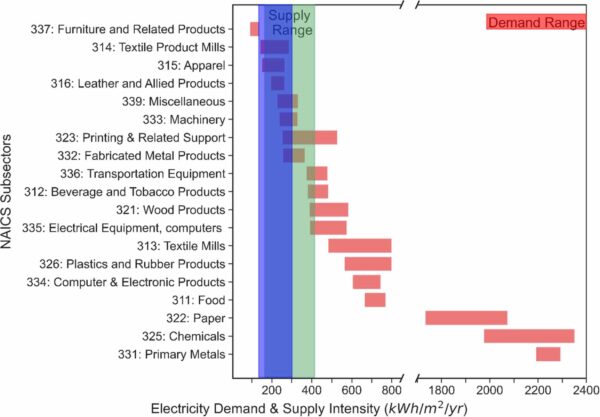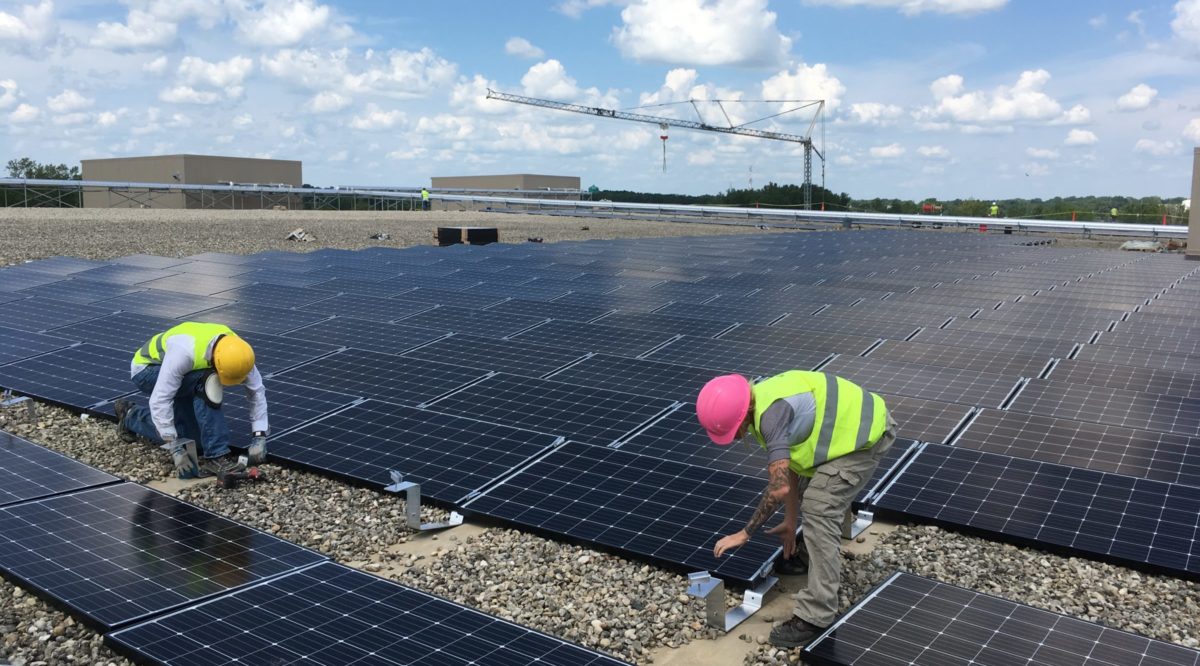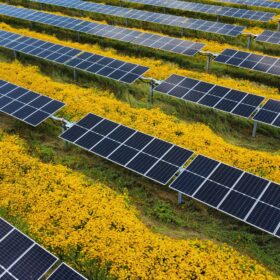Powering energy-intensive sectors of the U.S. economy with renewable energy would go a long way toward achieving the Biden Administration’s climate goals of reducing emissions by at least 50% from a 2005 baseline by 2030 and achieving net-zero pollution by 2050.
A recent study conducted at Northeastern University looked at how solar could power U.S. manufacturing. It found that solar mounted on industrial rooftops could meet the electricity demand of 35% of manufacturers.
According to the researchers, the industrial sector accounts for 38% of global energy consumption and 37% of greenhouse gas emissions. And with on-site sources of renewable energy currently supplying less than 0.1% of industrial electricity demand in the U.S., the opportunities for carbon reduction are great.
The study, Environmental Research: Sustainability and Infrastructure, published in IOP Publishing’s journal, looks at the feasibility of meeting these electricity demands through on-site rooftop solar installations for different regions and manufacturing sectors across the United States.
Using the U.S. Department of Energy Manufacturing Energy Consumption Survey from the Energy Information Administration, the researchers compared the potential electricity generation of rooftop solar arrays against the electricity demand per unit of floor space for the average manufacturing building.
Monthly solar generation potential per unit area was calculated using the system advisor model (SAM) for on-site roof-mounted panels for the capital of each U.S. state. SAM is a techno-economic analysis and energy simulation model, developed by the National Renewable Energy Laboratory (NREL) in collaboration with Sandia National Laboratories.
The model used 476 W (DC) SunPower solar modules with a 22% nominal efficiency on a fixed-mount solar system. The modeled ABB inverter has a 97.5% California Energy Commission weighted efficiency, maximum power of 20,000 W (AC) and maximum power point tracking of 800 V (DC), with an actual DC to AC ratio of 1.20. They ran the performance model based on hourly timestep simulations to calculate each system’s output by month, and they assumed that 90% of the rooftops were available for solar modules. They also conducted an alternative analysis on with modules that have a 16% nominal efficiency with only 80% of the roof covered with solar.
The researchers compared supply and demand on a net annual basis, under the assumption that facilities will make use of net metering.
The results show that rooftop solar arrays could fulfil the electricity requirement of 5% to 35% of U.S. manufacturing sectors, depending on the season. They found that manufacturers of furniture, textiles, and apparels set to benefit most, representing 2% of U.S. manufacturing electricity use and 6% of floorspace.

“Currently, less than 0.1% of the electricity required by the manufacturing sector in the U.S. is generated through renewable, on-site sources,” said Dr. Matthew Eckelman, associate professor of civil and environmental engineering at Northeastern University. “This must change if we are going to meet decarbonization goals, and in many cases rooftop solar panels are now a feasible option for supplying low-carbon energy.”
The alternative rooftop array design model was found to substantially shrink the range of supply intensities, from a high of 411 kWh m−2 yr−1 for the base case to just over 300 kWh m−2 yr−1, which is just within the range of demand intensities for the least electricity-intensive sector of furniture and related products. The researchers determined that the alternative model is not tenable for all of the other sectors in any U.S. location.
The study found that light manufacturing sectors such as furniture and apparel can cover their average net annual electricity demand with rooftop solar on their locations across the country. Other more intensive manufacturing industries can achieve electricity self-sufficiency, but in a smaller subset of U.S. locations.
An added benefit to pursuing on-site PV installations is that it enables manufacturers to maintain limited operations during periods of grid disruption, especially when coupled with on-site energy storage. Seasonally, manufacturing facilities with rooftop solar could fulfill their electrical needs in in nearly 40% of U.S. locations could in the spring and summer..
“Greater policy attention on the feasibility and potential benefits of rooftop solar panel arrays will help industries to achieve renewable energy and greenhouse gas emissions goals,” said Eckelman. “Our research provides an indication of the locations and sectors for which rooftop solar arrays could significantly help manufacturing firms to reach these goals.”
(Read: “U.S. Warehouses can host enough solar to power nearly 20 million homes“.)
This content is protected by copyright and may not be reused. If you want to cooperate with us and would like to reuse some of our content, please contact: editors@pv-magazine.com.









By submitting this form you agree to pv magazine using your data for the purposes of publishing your comment.
Your personal data will only be disclosed or otherwise transmitted to third parties for the purposes of spam filtering or if this is necessary for technical maintenance of the website. Any other transfer to third parties will not take place unless this is justified on the basis of applicable data protection regulations or if pv magazine is legally obliged to do so.
You may revoke this consent at any time with effect for the future, in which case your personal data will be deleted immediately. Otherwise, your data will be deleted if pv magazine has processed your request or the purpose of data storage is fulfilled.
Further information on data privacy can be found in our Data Protection Policy.